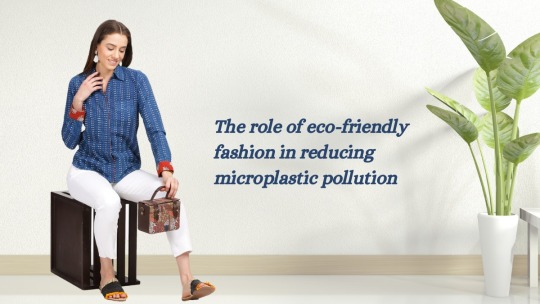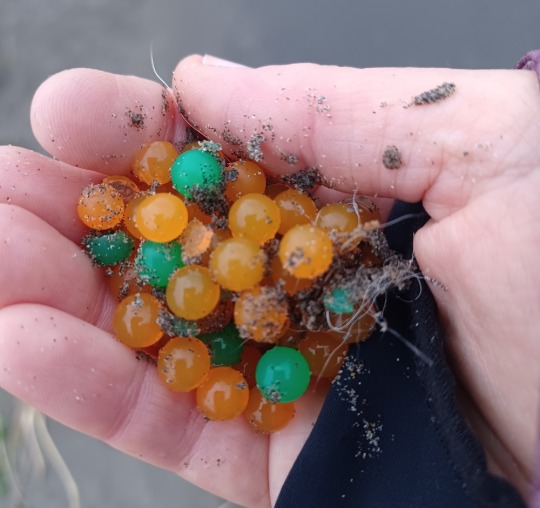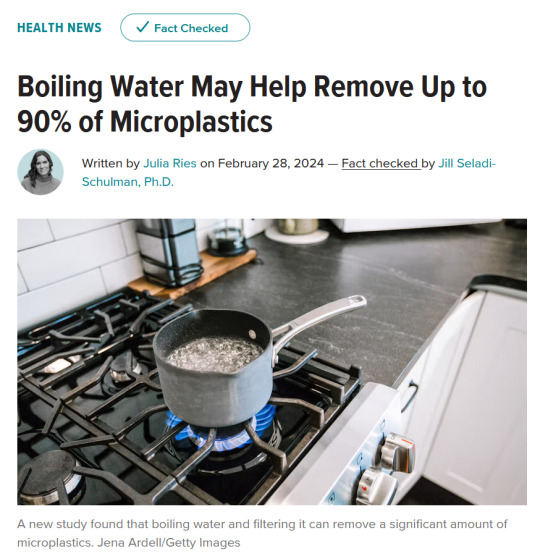#Microplastic Pollution
Explore tagged Tumblr posts
Text
From the article:
Researchers led by Takuzo Aida at the RIKEN Center for Emergent Matter Science (CEMS) have developed a durable plastic that won’t contribute to microplastic pollution in our oceans. The new material is as strong as conventional plastics and biodegradable, but what makes it special is that it breaks down in seawater. The new plastic is therefore expected to help reduce harmful microplastic pollution that accumulates in oceans and soil and eventually enters the food chain.
#biodegradable plastic#plastic#microplastic#microplastic pollution#plastic pollution#ocean pollution#ocean conservation#good news#hope#hopepunk#habitat#environment#ecology
974 notes
·
View notes
Text
Microplastics are now a ubiquitous part of our daily physical reality. These minuscule fragments of degrading plastic now suffuse our air, our soil, the food we eat and the water we drink. They’re being detected everywhere researchers look, from Antarctic sea ice to human brains. As scientists develop a better idea of where microplastics are accumulating in the environment, they’re just beginning to understand how these pollutants affect one of the most essential and widespread kingdoms of life on Earth: plants. A new study, published on Monday in the Proceedings of the National Academy of Sciences USA, reveals how microplastics hinder photosynthesis across a wide range of plant species—including crucial food crops. “It’s really scary,” says Marcus Eriksen, a marine scientist at the 5 Gyres Institute, a nonprofit plastic pollution research organization, who was not involved in the study. The researchers found that the presence of microplastics (plastic particles that are less than five millimeters in size) can reduce photosynthesis by as much as 7 to 12 percent, on average. That could range from 6 to 18 percent in terrestrial crops, 2 to 12 percent in marine plants such as seaweed and 4 to 14 percent in freshwater algae. “The exposure to microplastics was not surprising at all,” Eriksen says. “What surprised me was the level of impact.” A generalized reduction in photosynthesis at such a scale could have major implications for the global food supply, according to the study’s researchers.
continue reading
#us#microplastic pollution#global food supply#plant photosynthesis#reduced#food crops#yield reductions
19 notes
·
View notes
Text
Last Rites for a Dying Civilization
When the Black Death struck Europe in the Middle Ages, the fundamental values that held society together broke down. Husbands and wives abandoned each other and mother’s abandoned their children. This void of ethics that overtook the population is described in Boccaccio’s Decameron, considered a masterpiece of Italian prose and a documentary of life during that time. The book describes the…

View On WordPress
#Antarctic Ice Melt#Anthropogenic Global Warming#Authoritarianism#Climate Feedback Loops#Climate Tipping Points#Collapse of Industrial Civilization#Ecological Overshoot#Fossil Fuel Industry#Geoengineering#Global Pandemic#Greenwashing#Mass Coral Bleaching#Microplastic Pollution#Overpopulation#Peak Soil#Planetary Tipping Points#Techno-Fix#Techno-Optimists#The Black Death
3 notes
·
View notes
Text

#biodegradable fabrics#eco-friendly clothing#ethical fashion alternatives#fast fashion pollution#harmful clothing materials#microfibers in oceans#microplastic pollution#plastic in fashion#polyester environmental impact#polyester vs cotton#sustainable fabrics#sustainable fashion tips#synthetic fabric waste#unethical fashion materials#why is polyester bad#fashion
1 note
·
View note
Text
#biodegradable fabrics#eco-friendly clothing#ethical fashion alternatives#fast fashion pollution#harmful clothing materials#microfibers in oceans#microplastic pollution#plastic in fashion#polyester environmental impact#polyester vs cotton#sustainable fabrics#sustainable fashion tips#synthetic fabric waste#unethical fashion materials#why is polyester bad
0 notes
Text
"The substances behind the slimy strings from okra and the gel from fenugreek seeds could trap microplastics better than a commonly used synthetic polymer.
Texas researchers proposed in 2022 using these sticky natural polymers to clean up water. Now, they’ve found that okra and/or fenugreek extracts attracted and removed up to 90% of microplastics from ocean water, freshwater, and groundwater.
With funding from the U.S. Department of Energy, Rajani Srinivasan and colleagues at Tarleton State University found that the plant-based polymers from okra, fenugreek, and tamarind stick to microplastics, clumping together and sinking for easy separation from water.
In this next stage of the research, they have optimized the process for okra and fenugreek extracts and tested results in a variety of types of water.
To extract the sticky plant polymers, the team soaked sliced okra pods and blended fenugreek seeds in separate containers of water overnight. Then, researchers removed the dissolved extracts from each solution and dried them into powders.
Analyses published in the American Chemical Society journal showed that the powdered extracts contained polysaccharides, which are natural polymers. Initial tests in pure water spiked with microplastics showed that:
One gram of either powder in a quart (one liter) of water trapped microplastics the most effectively.
Dried okra and fenugreek extracts removed 67% and 93%, respectively, of the plastic in an hour.
A mixture of equal parts okra and fenugreek powder reached maximum removal efficiency (70%) within 30 minutes.
The natural polymers performed significantly better than the synthetic, commercially available polyacrylamide polymer used in wastewater treatment.
Then the researchers tested the plant extracts on real microplastic-polluted water. They collected samples from waterbodies around Texas and brought them to the lab. The plant extract removal efficiency changed depending on the original water source.
Okra worked best in ocean water (80%), fenugreek in groundwater (80-90%), and the 1:1 combination of okra and fenugreek in freshwater (77%).
The researchers hypothesize that the natural polymers had different efficiencies because each water sample had different types, sizes and shapes of microplastics.
Polyacrylamide, which is currently used to remove contaminants during wastewater treatment, has low toxicity, but its precursor acrylamide is considered toxic. Okra and fenugreek extracts could serve as biodegradable and nontoxic alternatives.
“Utilizing these plant-based extracts in water treatment will remove microplastics and other pollutants without introducing additional toxic substances to the treated water,” said Srinivasan in a media release, “thus reducing long-term health risks to the population.”
She had previously studied the use of food-grade plant extracts as non-toxic flocculants to remove textile-based pollutants from wastewater and thought, ‘Why not try microplastics?’"
-via Good News Network, May 10, 2025
#watere#water pollution#microplastics#plastic#plastic pollution#pollution#solarpunk#environment#okra#fenugreek#united states#north america#texas#environmental science#good news#hope
16K notes
·
View notes
Text

Mylar Love Balloons. Do not Biodegrade! Washington, DC Feb 2025 © julieb-b
1 note
·
View note
Text

This is going to be totally dismissed under the Trump administration, but…we should all be very, very concerned.
7K notes
·
View notes
Text
The Impact of Eco-Friendly Fashion on Mitigating Microplastic Pollution
Discover How Eco-Friendly Fashion Fights Microplastic Pollution! From choosing natural fabrics to advocating for policy change, eco-conscious fashion brands are leading the charge against microplastic pollution. Dive into our blog to learn about innovative solutions like Guppy Friend bags, circular fashion practices, and non-toxic dyeing methods. Empower yourself with knowledge and join the movement towards a cleaner, greener fashion industry. Visit our website to read the full blog and take the first step towards a more sustainable wardrobe!

0 notes
Text
From the article:
The two students presented their groundbreaking project at the 2024 International Science and Engineering Fair (ISEF); a device that operates by using ultrasound waves to push microplastic particles to one side of a water flow, allowing clean water to pass through while trapping the contaminants. In their tests, the system successfully captured up to 94 per cent of microplastic particles, showing promise for real-world applications. "If we could refine this, maybe use more professional equipment, maybe go to a lab instead of testing from our home, we could really improve our device and get it ready for large-scale manufacturing," Justin told Business Insider. The duo envisioned their device being used in water treatment plants, directly modifying the quality of water for daily use. This application could significantly reduce the amount of microplastics that end up in water sources, protecting ecosystems and human health.
#microplastics#water filtration#plastics#plastic pollution#pollution#good news#environment#sustainability#hope#hopepunk#ecology#water conservation
2K notes
·
View notes
Text
It's a disturbing thought: At this very moment, tiny crumbs of plastic are trickling through our bodies, a parade of unwelcome houseguests ready to take up residence in some tissue or organ. A wave of new studies has come out recently, and each one seems to paint an ever more vivid picture of how microplastics — and their smaller counterparts, nanoplastics — have infiltrated the deepest corners of our anatomy. The lungs, liver and heart, guts and brain, even the testicles and placenta — nothing seems to be spared. The outpouring of research has brought enormous visibility to how these fragments permeate our daily lives. Long studied in oceans, waterways and marine life, researchers have now shifted focus to human health. A decade ago, Heather Leslie could scarcely find anyone to fund her work in this area. "It seemed like nobody wanted to touch it," says Leslie, a microplastics researcher in the Netherlands whose team was the first to detect these particles in the human bloodstream several years ago. As the work has gained momentum, so have questions about the damage microplastics could be doing inside of us. Researchers tend to be wary about making pronouncements because the field is still in a "pioneering phase," as Leslie put it. And yet there are undoubtedly concerns. Some of the strongest evidence comes from lab studies using animals as well as what's already known about the damaging effects of chemicals added to plastics. A review of the data published Wednesday concludes that microplastics are "suspected" to harm human reproductive, digestive and respiratory health, with a possible link to colon and lung cancer. "This is a signal that we should be acting now," says Tracey Woodruff, a senior author on the study who directs the Program on Reproductive Health & the Environment at the University of California, San Francisco. Susanne Brander, an ecotoxicologist at Oregon State University, says it's not helpful to "elicit a gigantic state of alarm," but she agrees that we already know enough about the health risks to push for substantive changes, including a global agreement to curb the rising production of plastics. As they push to solve the puzzle of microplastics, here are six questions scientists are trying to answer.
continue reading
0 notes
Text
Biodiversity Collapse, Climate Feedback Loops, the Population Bottleneck , and Human Extinction
Introduction: The Dual Crisis of Our Time Humanity stands at a crossroads unlike any in its history, facing a dual existential crisis: the rapid unraveling of Earth’s biodiversity and the accelerating destabilization of its climate. These intertwined threats, driven by human activity, are propelling us toward a bottleneck scenario—a drastic reduction in global population and societal complexity.…

View On WordPress
#6th Mass Extinction#Albedo Loss#Amazon Die-Off#Antarctic Ice Melt#Anthropogenic Climate Disruption (ACD)#Authoritarianism#Biological Annihilation#Climate Change#Climate Tipping Points#Cretaceous-Paleogene Extinction#Dystopic Future#Forever Chemicals#Genetic Erosion#Human Bottleneck#Human Extinction#Hypercane#Megadrought#MegaFires#Methane Time Bomb#Microplastic Pollution#Nuclear Radiation#PFAS#Polycrisis#Radioactive Waste#superstorm
0 notes
Text

Welcome to my Tuesday morning PSA about plastics!
So--I was walking along the Bolstadt beach approach sidewalk here in Long Beach, WA yesterday afternoon, and I started seeing these little orange pellets on the ground that looked a little bit like salmon roe (but probably weren't). So I picked one up, and it was most definitely rubber. I went around picking up every one I could find, and while I didn't keep exact count I probably amassed 50-60 of them. I took this picture before depositing them in the nearest trash can.
These are airsoft gun pellets, and you can buy them in big jars containing thousands of them. That means that someone who decided that the beach was a great place to shoot their airsoft guns could easily litter the place with countless little bits of plastic rubber in less than an hour. We already have a huge problem here with people leaving trash, including tiny bits of plastic, all over the beach (you should see the gigantic mess after 4th of July fireworks when thousands of people come in from out of town, blow things up, and then leave again without picking up after themselves.)
But these airsoft pellets have a particularly nasty side effect. You know how my first thought was "wow, those look kind of like salmon roe?" Well, we have a number of opportunistic omnivore birds like crows, ravens, and several species of gull that commonly scavenge on the beach, especially along the approaches because people often feed them there. If I can catch the resemblance of an orange airsoft pellet to a fish egg, then chances are there are wildlife that will assume they're edible.
Since birds don't chew their food, they probably won't notice that the taste or texture is wrong--it'll just go down the hatch. And since they can't digest the pellets, there's a good chance they might just build up in the bird's digestive system, especially if the bird eats a large number of them--say, fifty or sixty of them dropped on the ground along the same fifty foot stretch of sidewalk. The bird might die of starvation if there's not enough capacity for food in their stomach--or they might just die painfully of an impacted gut, and no way to get help for it. If the pellets end up washed into the ocean, you get the same issue with fish and other marine wildlife eating them, and then of course the pellets eventually breaking up into microplastic particles.
You can get biodegradable airsoft pellets; they appear to mainly be gray or white in color rather than bright screaming orange and green. But "biodegradable" doesn't mean "instantly dissolves the next time it rains." An Amazon listing for Aim Green biodegradable airsoft pellets advertise them as "Our biodegradable BBs are engineered to degrade only with long-term exposure to water and sun and will degrade 180 days after being used." That's half a year for them to be eaten by wildlife.
I don't know, y'all. That handful of carelessly dropped rubber pellets just encapsulates how much people don't factor in the rest of nature when making decisions, even on something that is purely for entertainment like an airsoft gun. We could have had a lot of the same technological advances we have today, but with much less environmental impact, if we had considered the long-term effects on both other people and other living beings, as well as our habitats. We could have found ways from the beginning to make these things in ways that benefited us but also mitigated any harm as much as possible. Instead we're now having to reverse-engineer things we've been using for decades, and sometimes--like the "biodegradable" airsoft pellets--they still have a significant negative impact.
But--at least there are people trying to do things better, thinking ahead instead of just on immediate profit. We're stuck in a heck of a mess here, figuratively and literally, and changing an entire system can't be done in a day. Maybe we can at least keep pushing for a cultural shift that emphasizes planning far into the future--if not the often-cited "seven generations ahead", then at least throughout the potential lifespan of a given product.
#plastics#microplastics#environment#environmentalism#conservation#nature#pollution#litter#birds#tw animal death#animal welfare#ecology#science#wildlife#animals#scicomm#pnw#airsoft#biodegradable#solarpunk
4K notes
·
View notes
Text
With microplastics now permeating our food and our bodies, researchers are keen to assess the potential damage these tiny fragments could be doing. A new study shows how plastics may lead to dangerous blood flow blockages in the brain. The study, led by a team from the Chinese Research Academy of Environmental Sciences in Beijing, involved tracking microplastics in blood vessels moving through mouse brains in real time – the first time microplastic movement has been tracked in this way.
Continue Reading.
643 notes
·
View notes
Text

ETA: Article here (can't believe I forgot this rip)
A new study finds you can reduce the amount of microplastics you drink simply by boiling your water.
Scientists are just beginning to understand the health risks associated with microplastic exposure.
Nano- and microplastics are bits of plastic as tiny as one-thousandth of a millimeter in diameter.
Boiling and filtering your tap water may dramatically lower the amount of microplastics you drink, according to new research.
Recent studies have found that nano- and microplastics (NMPs), which are bits of plastic as tiny as one-thousandth of a millimeter in diameter, have been found in a host of products and even in tap water.
A new study, published February 28 in Environmental Science & Technology Letters, found that boiling mineral-rich water for just five minutes can reduce the amount of NMP you’re exposed to by up to 90%.
Scientists are just beginning to understand the health risks associated with microplastic exposureTrusted Source, but growing evidenceTrusted Source suggests the plastics can accumulate in the body and trigger oxidative stress, inflammation, insulin resistance, and liver issues.
Certain advanced water filtration systems can capture and help remove some NMPs from tap water. But researchers wanted to figure out other options to remove microplastics, especially since in poorer countries cheaper, more accessible solutions for clean water are needed.
Boiling water may be a safe, simple solution that can effectively decontaminate household tap water, the new findings suggest.
“Boiling water before drinking is a great example of an ancient cultural practice that can help reduce an environmental exposure,” Dr. Luz Claudio, PhD, a professor of environmental medicine and public health at the Icahn School of Medicine at Mount Sinai, told Healthline.
Claudio was not involved in the study.
How boiling water can help remove microplastics
The researchers found simply boiling water is the first step to removing NMPs from tap water.
The researchers collected multiple samples of tap water from Guangzhou, China and contaminated the samples with varying levels of NMPs.
Each sample was boiled for five minutes then left to cool for 10 minutes.
Boiling hard water that’s rich with minerals — such as calcium or magnesium — creates a chalk-like residue known as limescale, or calcium carbonate (CaCO3), which can trap the plastics.
That solid, chalky residue then had to be separated and removed from the water with a standard coffee filter or stainless steel filter, thereby removing NMPs.
The team found that the impact was greatest in harder water: In samples that had 300 milligrams of CaCO3, for example, nearly 90% of NMPs were removed.
In softer water samples with less than 60 mg of CaCO3, roughly 25% of NMPs were removed.
“What’s important to note here is that the effectiveness of trapping these micro/nano plastics in these mineral solids is tied to how hard the water is – the harder the water, the more solids are formed, the more microplastics are trapped,” Dr. Anja Brandon, PhD, the associate director of U.S. plastics policy at Ocean Conservancy and an environmental engineer, told Healthline.
Brandon was not involved in the study...
How to limit your exposure to microplastics
Anyone who wishes to boil their water should do so in a glass or stainless steel pot.
After boiling the water for about five minutes, let it cool, and do not stir it, Claudio says.
The microplastics need to bind to the calcium and fall to the bottom of the pot so they can filtered or scooped out."
-via Healthline, February 28, 2024
#microplastics#nanoplastics#hard water#calcium carbonate#public health#plastic pollution#good news#hope
3K notes
·
View notes